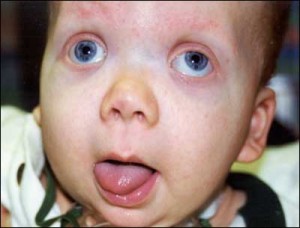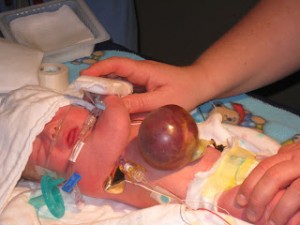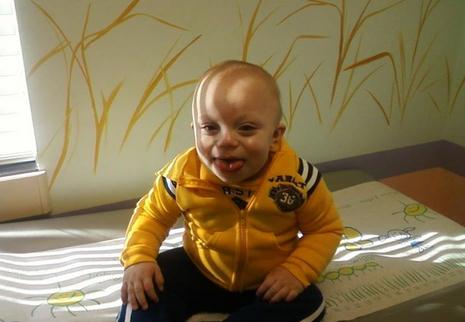Beckwith Wiedemann Syndrome Pictures, Prognosis, Management
What is Beckwith-Wiedemann syndrome?
Beckwith-wiedemann syndrome (BWS) is a congenital, autosomal dominant disorder characterized by overgrowth, congenital malformation, and tumor predisposition. It is commonly described by the following features: macroglossia (enlargement of the tongue), macrosomia or big baby syndrome, and defects in the abdominal wall (such as umbilical hernia, diastis recti, or omphalocele).
 A child with Beckwith-Wiedemann Syndrome
A child with Beckwith-Wiedemann Syndrome
It was in 1964 when German pediatrician Dr. Han-Rudolf Wiedemann first reported cases of omphalocele with macroglossia. Five years later, American Pathologist Dr. J. Bruce Beckwith also reported some of the same symptoms encountered in some of his patients.
Signs and symptoms
The main features of Beckwith-Wiedemann syndrome are the following:
1. Macrosomia
Macrosomia or big baby syndrome is defined as infants whose weight is more than four kilograms regardless of the gestational age. In 25 percent of such cases, hemihypertrophy occurs, a condition where one side of the body is larger than the other.
2. Macroglossia
Macroglossia is the abnormal enlargement of the tongue, and it is the most frequent symptom of BWS. It may cause feeding problems, delayed speech (due to problems in formation of clear and distinct sounds), and obstructive sleep and feeding apnea. Untreated macroglossia, if left untreated, may result in prognathism (anterior open bite and dental problems).
3. Abdominal wall defect
The majority of babies with BWS are born with omphalocele, a condition in which there is an opening in the wall of the abdomen and the intestines and where other organs remain outside the abdomen and protrude through the navel. Other abdominal wall defects, including umbilical hernia and exomphalos, are also common.

An omphalocele with the abdominal contents protruding through the umbilical area
Other features of Beckwith Wiedemann syndrome include:
4. Genitourinary disorders
For example, medullary dysplasia, nephracalcinosis, medullary sponge kidney, and nephromegaly
5. Ear anomalies
For example, anterior linear earlobe creases and posterior helical pits
6. Neonatal hypoglycemia
The majority of patients with BWS encounter hypoglycemia (low level of sugar in the blood). It can be mild and transient, or it can be severe and persistent. Uncontrolled hypoglycemia may lead to neurological damage.
Causes and risk factors
Idiopathy
The primary cause of BWS is still unknown.
Genetics
Family history
An estimated 15 percent of BWS patients have a family history of the disease and have inherited it as an autosomal dominant trait with incomplete penetrance. Parent-of-origin differences in penetrance is more complete if the mother is the transmitting parent.
Diagnosis
Blood glucose test
A blood sugar level test is given among patients suspected of BWS. Proper blood sample collection is necessary to obtain accurate values. Hypoglycemia is considered if the result is lower than 60mg/dl.
Ultrasound
Abdominal ultrasound is suggested to inspect the child’s abdomen for any anomalies.
Treatment
Macroglossia
Surgical tongue reduction is performed in up to 50 percent of cases, usually among infants aged 2 -3 years old, but it can be done earlier if feeding problems and obstruction occur.
Hypoglycemia
Frequent feedings and intravenous or subcutaneous injection of glucagon are needed to treat low blood sugar level.
Hemihypertrophy
For mild cases, physiotherapy and conservative orthopaedic treatment are needed, but in severe cases of hypertrophy, surgical procedures are needed to perform when the child reach puberty.
Wilms’ tumor
Nephrectomy is advised among children diagnosed with Wilms’ tumor, a rare form of kidney cancer.
Prognosis
Stable airway and immediate response to hypoglycemia make the prognosis fairly stable.
Complications
Neoplasia
Children with BWS who suffer from neoplasia are at a high risk of developing several types of tumors. About 10 percent of people with BWS develop tumors which commonly and almost always, appear during childhood. The most common is Wilms’ tumor followed by Adrenocortical carcinoma. Other types of cancer are rhabdomyosarcoma (cancer of muscle tissue) and hepatoblastoma (a form of liver cancer).
Pulmonary disease and congenital heart disease
Pulmonary disease and congenital heart disease related to prematurity are the leading causes of early death.
Prevention
Cancer screening
If a tumor has been detected, immediate screening is made to initiate early treatment. This may decreased the rate of morbidity. Ultrasound screening is done each trimester until the child is 6 years old.
Consultation
Regular medical check-ups with one’s doctor are important for early detection of other diseases that may arise along with BWS. They also decrease the possibility of untreated complications.
Beckwith Wiedemann Pictures

